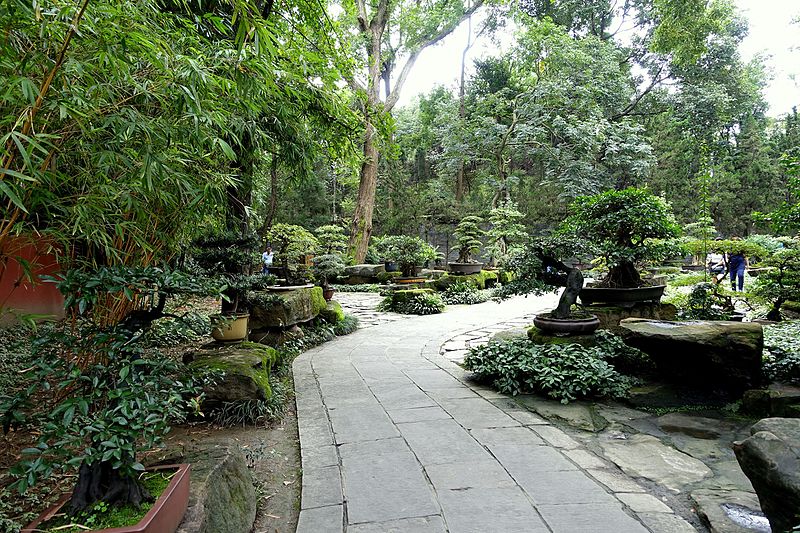Wuhou Shrine, also known as the Temple of Marquis Wu, is a renowned historical site located in Chengdu, Sichuan Province, China. Dedicated to Zhuge Liang, the celebrated military strategist of the Three Kingdoms period, the shrine was originally built in 223 AD. The current complex dates back to 1672 during the Qing Dynasty. Covering an area of 37,000 square meters, Wuhou Shrine features traditional Chinese architecture, including halls, courtyards, and gardens. It houses numerous cultural relics, statues, and steles related to Zhuge Liang and the Three Kingdoms era. As one of China’s most important historical and cultural landmarks, Wuhou Shrine attracts millions of visitors annually, offering insight into ancient Chinese history, literature, and architecture.
Wuhou Shrine, located in Chengdu, China, is a treasure trove of ancient artifacts that offer visitors a glimpse into the rich history of the Three Kingdoms period. As you step into this hallowed ground, you’ll find yourself surrounded by a wealth of historical relics that have stood the test of time, each with its own fascinating story to tell.
One of the most striking features of the shrine is its impressive collection of stone tablets. These massive slabs of rock, some dating back over a thousand years, are adorned with intricate carvings and inscriptions that provide valuable insights into the lives and accomplishments of notable figures from the Three Kingdoms era. As you wander through the grounds, you’ll come across tablets dedicated to Zhuge Liang, the brilliant strategist who served as chancellor to Liu Bei, founder of the Shu Han state. These tablets not only commemorate his achievements but also serve as a testament to the enduring respect and admiration he commands even centuries after his death.
Moving on from the stone tablets, you’ll encounter a diverse array of ancient weapons and armor on display throughout the shrine. These artifacts offer a tangible connection to the military prowess of the Three Kingdoms period, allowing visitors to imagine the fierce battles that shaped the course of Chinese history. From intricately crafted swords and spears to sturdy shields and ornate helmets, each piece tells a story of the skilled craftsmen who created them and the brave warriors who wielded them in combat.
As you continue your exploration, you’ll come across a collection of ancient seals and official documents that provide a fascinating glimpse into the administrative and bureaucratic aspects of life during the Three Kingdoms period. These artifacts offer valuable insights into the complex system of governance that existed at the time, shedding light on everything from tax collection to military conscription.
One of the most captivating aspects of Wuhou Shrine’s artifact collection is the array of personal items that once belonged to prominent figures of the era. From ornate jade pendants and delicate porcelain vases to intricately carved wooden furniture, these objects offer a more intimate look at the daily lives and tastes of the nobility and elite during this tumultuous period in Chinese history.
As you make your way through the shrine, you’ll also encounter a number of beautifully preserved paintings and calligraphy works. These artistic treasures not only showcase the incredible skill of ancient Chinese artists but also provide valuable historical information through their depictions of important events, landscapes, and individuals from the Three Kingdoms period.
One particularly fascinating aspect of the artifact collection at Wuhou Shrine is the presence of numerous bronze vessels. These intricately crafted objects, ranging from small cups to large cauldrons, were often used in religious ceremonies and rituals. Their presence at the shrine serves as a reminder of the important role that spirituality and ancestor worship played in ancient Chinese society.
As your journey through the ancient artifacts of Wuhou Shrine comes to an end, you’ll likely find yourself marveling at the incredible craftsmanship and historical significance of the objects you’ve encountered. From massive stone tablets to delicate porcelain vases, each artifact tells a unique story and contributes to our understanding of this fascinating period in Chinese history. The diverse collection at Wuhou Shrine serves as a testament to the enduring legacy of the Three Kingdoms era and offers visitors a truly immersive experience that brings the past to life in vivid detail.Wuhou Shrine stands as a significant historical and cultural landmark in Chengdu, China, dedicated to the memory of Zhuge Liang, a renowned strategist during the Three Kingdoms period. The shrine’s architecture, artifacts, and gardens offer visitors a glimpse into ancient Chinese history and the enduring legacy of Zhuge Liang. As a popular tourist destination and educational site, Wuhou Shrine continues to play an important role in preserving and promoting Chinese cultural heritage, serving as a testament to the lasting impact of Zhuge Liang’s contributions to Chinese history and literature.

